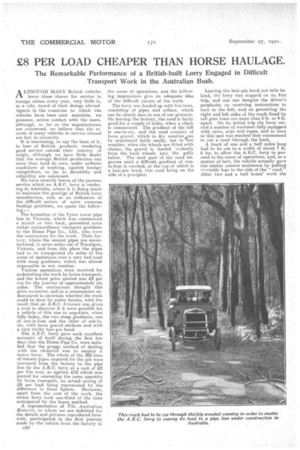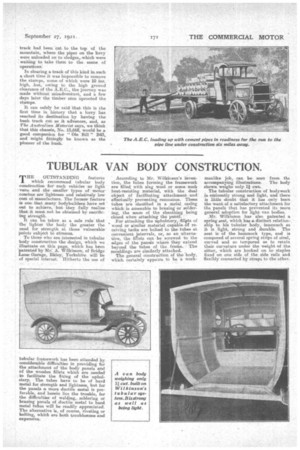ES PER LOAD CHEAPER THAN HORSE HAULAGE.
Page 10

Page 11

If you've noticed an error in this article please click here to report it so we can fix it.
The Remarkable Performance of a British-built Lorry Engaged in Difficult Transport Work in the Augtralian Bush.
ALTHOUGH MANY British vehicles leave these shores for service in foreign climes every year, very little is, as a rule, heard of their doings abroad. Agents in the countries to which the. vehicles have been :sent maintain, we presume, active contact with the users, although, so far as the manufacturers are concerned, we believe that the records of many vehicles in service abroad are lost in obscurity.
It is heartening, to say the least of it, to hear of British products rendering good service outside their country of origin, although we have little doubt that the average British produiction can more than hold its own, under arduous conditions of working, against foreign competitors, to far as durability and reliability are concerned.
We have recently learnt of the yeoman service which an A.E.C. lorry•is rendering in Australia, where it is doing much to maintain the prestige of British lorry manufacture, and, as an Indication of the difficult nature of some overseas haulage problems, we quote the following : The formation of the Tyers water pipe Ibis in Victoria, which was commenced a month or two back, presented some rather extraordinary transport problems to the Hume Pipe Co., Ltd., who were the contractors for the work. Their factory, where the cement pipes are manufactured, is seven miles out of Traralgon, Victoria, and from this place the pipes had to be transported six miles to the scene of operations over a very had road with steep gradients, which was almost impassable in wet weather.
Various quotations were received for undertaking the work by horse transport, . and the lowest price quoted was £2 per ton for the journey of approximately six miles. The contractors thought this price excessive, and as a consequence endeavoured to ascertain whether the work could be done by motor lorries, with the result that an A.E.C. 5-tormer was given a trial to discover if it were possible for a vehicle of this Si20 to negotiate, when fully laden, the two steep gradients, one of one-in-four and the other of one-insix, with loose gravel surfaces and with a very tricks* hair-pin bend.
The A.E. lorry gave such excellent accounts of itself during the first few days that the Hume Pipe Co. were satisfied that the proper method of dealing with the situation was to employ motor lorry. The whole of the 300 tons of Cement pipes required for the job were conveyed from the factory to the pipe line by the A.E.C. lorry at a cost of 12 per five tons, as against £10 which.was quoted for conveying the same quantity by horse transport, an actual saving of a per load being represented by the difference iif these figures. Moreover, apart from the cost of the work, the motor lorry took one-third of the 'time anticipated by the horse method.
A representative. of TheAudral;an Motorist-, to whom we are indebted for the details and pictures reproduced herewith, participated in the firstjourney made by the vehicle from the factory to
C20 the scene of operations, and the following impressions give an adequate idea of the difficult nature of' the work.
The lorry was loaded up with five tons, consisting of pipes and collars, which can be clearly seen in one of our pictures. On leaving the factory, the road is fairly good for a couple of miles, when a climb is commenced. The gradient of the hill is one-in-six, and the road consists of loose gravel, which in dry weather can be negotiated fairly easily, but in 'et weather, when the wheels are fitted with chains, the gravel is hurled violently from the back wheels into the gully below. The next part of the road improves until a difficult gradient of onein-four is reached, at the top of which is a. hair-pin bend, this road being on the side of a precipice.
Leaving the hair-pin bend one mile be hind, the lorry was stopped on its first trip, and ode can imagine the driver's perplexity on receiving instructions to turn to the left, and on perceiving the right and left sides of the roads lined by tall gum trees not more than 3 ft. or 4 ft. apart. On its initial trip the lorry carried a number of workmen fully equipped with saws, as4s and ropes, and so soon as this spot was reached they commenced to cut a road through the bush. A track of one and a half miles long had to be cut to a width of about 7 ft. 6 ins, to allow the A.B.C. lorry to proceed to the scene of operations, and, as a matter" of fact, the vehicle actually gave thes thither cutters assistance by pulling His wieldy logs to the side of the " road." After two and a half hours' work the
track had been cut to the top of the mountain, where the pipes on the lorry were unloaded on to sledges,which were • waiting to take them to the scene of operations.
In clearing a track of this kind in such a short time it was impossible to remove the stumps, some of which were 10 ins. high, but, owing to the high groundclearance of the A.E.C., the journey was made without misadventure, and a few days latet the timber Men uprooted the stumps.
It can safely be said that this is the first time in history that a lorry has reached its destination by having the bush track cut as it advances, and, as The Australian Motorist says, we think that this chassis, No. 15,668, would be a good companion for "Ole Bill" B43, and might fittingly be known as the pioneer of the bush.


































